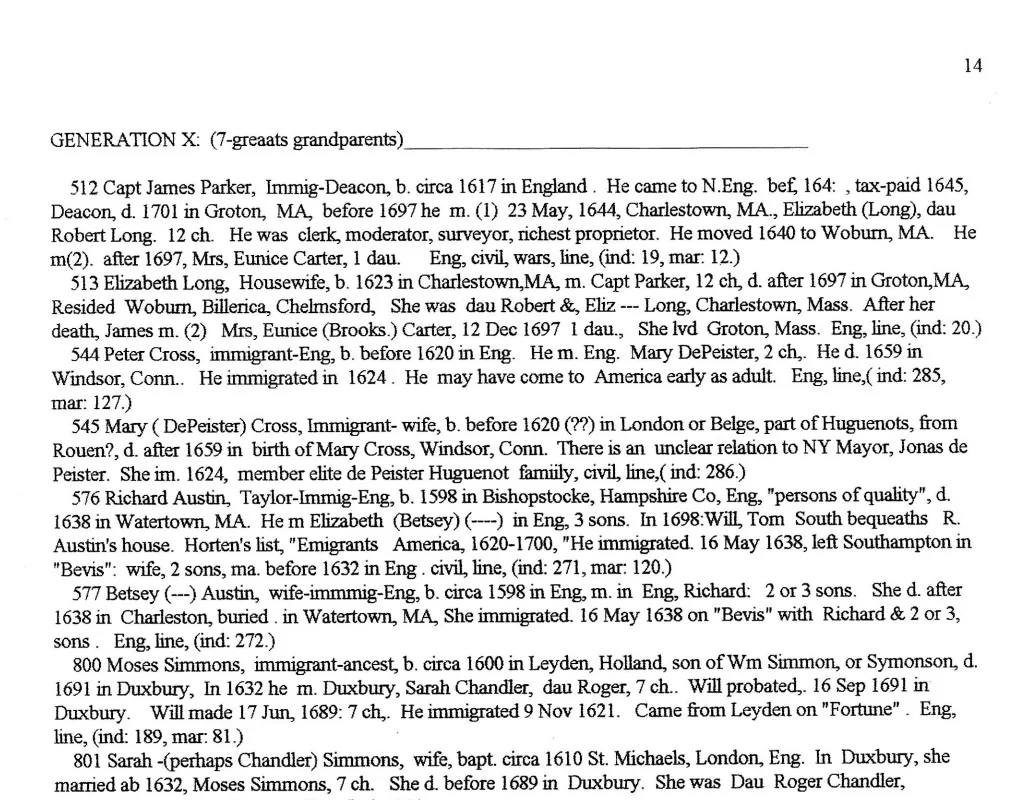Do you want to learn about ahnentafel in genealogy? In this post, learn what this term means and how you can use this system for your genealogy research.
If you have been building a family tree for any length of time, you have already noticed that your family tree can quickly become confusing. We have so many ancestors that it can be tough to keep track of their names, how they are related, and exactly where they fall on our tree.

A few months ago, a close cousin sent me more than a dozen boxes of family tree research that was done by my great-grandmother and her mother-in-law, my great-great grandmother. One of the first things that I noticed in the documents was an ahnentafel for all their recent ancestors.
Of course, I had seen this term before, but I had never jumped in to using it myself. Since all of the records that I have are organized according to this system, I was motivated to learn more about it.
What does ahnentafel mean in genealogy?
Ahnentafel literally means "ancestor table". Family tree researchers and genealogists use the annentafel numbering system to make a list of all of the ancestors of a specific person.
Each ancestor is assigned a number, with the person whose ancestors are being named in the list having the number of "1". Then, numbers are assigned to previous generations in a specific order.
The word "ahnentafel" comes from the German language. Roughly, "ahnen" means "ancestral" and "tafel" means "display board".
So, the literal translation of ahnentafel means "ancestral display board".
As we all know, royal and noble families have been especially proud about their ancestry, and so sometimes this display of ancestors historically included pedigree charts and even coats of arms.
However, the modern interpretation of an ahnentafel chart is more like a list of ancestors.
Origin of ahnentafel in genealogy
The ahnentafel system has been in use in Europe since at least 1590, when the Austrian diplomat, Michaël Eytzinger, published the principles of the system. Initially, the system was primarily applied to descendants of royalty.
Over the course of time, this method of charting and listing ancestors has become more interesting and accessible to the average person. In other words, both you and I can learn how to make these charts and use them to keep track of our family tree research.
It should be noted that pedigree charts and documentation of ancestry has not been limited to European countries. Many cultures around the world have placed a strong emphasis on documenting a family's ancestors, and many of these traditions also included physical charts.
How ahnentafel charts are useful
At this point, you are likely wondering why you would want to make a list of your ancestors. Isn't it enough work just to build an accurate family tree?
There are several reasons that the ahnentafel numbering system and the resulting charts are useful.
- Sometimes it is not practical to make pedigree charts
- Pedigree charts need a lot of space
- Ahnentafel numbers are a uniform way to refer to ancestors
- You can easily see how people are related to each other
- It's a fast way to list ancestors
- It doesn't take up much space, so you can list as many ancestors as you want
- You can easily make a new chart for a different person
- Many software programs automatically produce ahnentafel charts
- These charts are easy to share with others
Just recently, it occurred to me that we can combine the ahentafel system, which is relic from the Early Modern Age of history, with technology from the 21st century. For example, you could make a ahnentafel chart and have hyperlinks in the document for each ancestor that lead to a separate page in the document with more information about the ancestor.
You could include a written narrative about the ancestor, photographs, and other genealogy records. This is a project you could work on as you can, adding hyperlinks ancestor-by-ancestor as you have time.
I am thinking of creating a Google Doc with this type of chart and sharing the link to the document with my relatives. This way, they can see what I am working on as I go, and they can explore their (our!) list of ancestors as they wish.
We have all struggled with ways to share our family tree work, and the ahnentafel system can make it easier to do so.
How do you make an ahnentafel chart?
All you need to make an ahnentafel chart is a piece of paper or a place to type your chart in on your phone or computer, such as a Microsoft Word, Excel, or Google Docs file. In addition, you will need to decide before you start which details you would like to include about your ancestors on the chart.
You can include only a few generations on your chart or all of the generations that you have on your tree. If you have some blank spots in your family tree, don't worry - you can skip those numbers.
Before you get started on making your chart, make sure that you don't already have a genealogy software program that will automatically generate this chart for you, since most family tree programs will. Those who are subscribers to Ancestry Pro Tools should know that the option to automatically generate an ahnentafel chart is available in "charts and reports".
How to number an ahnentafel
The most confusing aspect of making the ahnentafel chart is using the numbering system. Fortunately, if you start with yourself, or the main person you are making the chart for, the system works very easily.
This is how the numbering system works for four generations, going back to your great grandparents and including yourself for the first generation:
- you: 1
- your father: 2
- your mother: 3
- your father's father: 4
- your father's mother: 5
- your mother's father: 6
- your mother's mother: 7
- your father's father's father: 8
- your father's father's mother: 9
- your father's mother's father: 10
- your father's mother's mother: 11
- your mother's father's father: 12
- your mother's father's mother: 13
- your mother's mother's father: 14
- your mother's mother's mother: 15
If you ever get confused, you can open up your family tree and view it with the pedigree view and count from your position in the tree, starting at one, and then from the top from each generation, until you get to where you left off or got confused.
How to calculate an ancestor's ahnentafel number
If you are making a chart with missing people, as would be the case if you don't know all of your ancestors, you might need to calculate the number of a specific ancestor. The easy rule of thumb to use is that, for any given person in the list, their father's number is their number times 2, and their mother's number is the person's number times 2 plus 1.
If this seems complicated to you, the easiest thing to do is use Steve Morse's calculator.
You should use the calculator's option of "Converting Relationship to Ahnentafel Number", and you will have to press the "mother('s)" and "father('s)" buttons as necessary to indicate how your ancestor is related. For example, if you want to know your paternal grandmother's number, you would press "father('s)" and "mother('s)" to arrive at the number of 5.
Of course, this can be very confusing if you are going back many generations, so I would recommend calculating it twice to be sure that you have arrived at the right number. You might also want to write it down on a piece of paper to be sure you don't miss a step.
How far back can an ahnentafel chart go?
There is no limit to how many generations back you can take an ahnentafel chart. The length of the chart that you make is only limited by how many ancestors you have identified on all lines of your family tree.
We have a lot of ancestors, so a very complete ahnentafel chart could be quite extensive.
If you are interested in making a list of ancestors using the ahnentafel numbering system, but you don't know who all of your ancestors are on all lines, that's okay. You can include only your known ancestors by calculating their number, and only include those numbered ancestors in your chart.
For example, in the image below you can see an example of an ahnentafel chart from my great-grandfather's ahnentafel chart that was made by my great-grandmother. The sample is of the page that shows his 10th generation ancestors, or his great-great-great-great-great-great-great grandparents.

Not many people will have identified every single ancestor going back ten generations. After all, this would be about 1022 ancestors in all.
If you look closely at my great-grandfather's chart, you can see that he didn't know the names of all of his ancestors at that generation, either. This is why you see only ancestor #512, 514, 544, 545, 576, 577, 800, and 801.
In my case, all other ancestors for this generation were unknown to my great-grandfather, which is why only a few were listed on the report.
Conclusion
I hope that this post has helped you understand more about the ahnentafel numbering system and how you can use this method of keeping up with ancestors for your own use.
If you have any questions or comments, I would very much like to hear from you in the comments.
Thanks for stopping by today!
